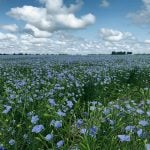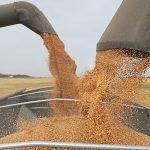According to a recent profitability analysis by Rayglen Commodities of Saskatoon, lentils have the potential to be a top money earner for the upcoming growing season while flax, soybeans and fababeans are at the bottom of the list. Changing price projections have altered the expected profitability for many crops over the past couple months. Saskatchewan […] Read more
Flax

Increasing flax yields faces genetic challenges
Researchers who want to optimize flax for seed production must backtrack on 8,000 years of agricultural development
SASKATOON — When Bunyamin Tar’an introduced a new flax variety, CDC Esme, to an audience of farmers, the question from the floor was immediate: what about the straw? “Similar to (CDC) Glas,” he said. “Almost all the plants have similar structure. A lot of the challenge with flax is that the straw is really, really […] Read more
Canola-flax merger gets final approval
SASKATOON — Saskatchewan’s canola and flax growers have voted to approve the amalgamation of their two grower groups. Resolutions were passed at both the Saskatchewan Canola Development Commission (SaskCanola) and Saskatchewan Flax Development Commission (SaskFlax) annual general meetings. “The collaborative efforts are expected to streamline operations, enhance research initiatives and provide a more cohesive voice […] Read more

Sask. canola, flax groups vote to merge
SaskCanola and SaskFlax have been sharing offices, admin for about a year
Saskatchewan flax and canola growers approved plans to amalgamate their organizations in a Jan. 9 vote. Producer support for the merger of SaskCanola and SaskFlax was “overwhelming,” the groups said in a Jan. 10 news release. The organizations held a joint annual general meeting to share results of member feedback before taking the issue to […] Read more

Flax price stable as production woes continue
SASKATOON — Global flax production problems are raising prices in the European market but not yet in Canada. Oil World estimates global production at 2.94 million tonnes, a 21 percent reduction from the previous year. “Deteriorating profit margins induced farmers not only in Canada but also in Russia and Kazakhstan to shift to more lucrative […] Read more

Producers urged to use grain grading tools
Grain grading isn’t the exclusive purview of elevator operators and private consultants. The information necessary for producers to survey quality, short of an official grade, is publicly available, according to recent seminars hosted by Saskatchewan producer groups. Saskatchewan wheat, barley, canola and flax associations hosted officials from the Canadian Grain Commission for a crash course […] Read more

Manitoba sees wide range in yield and moisture issues
Government ministry issues final crop report of the season as it summarizes how different crops fared in the province
Central Manitoba farmers reported a significant drop in yields this year, based on the provincial government’s year-end summary. It said producers in these drier regions had yields of 30 to 35 bushels per acre compared to the provincial average, which was between 55 and 60 bu. per acre. Acres that received much-needed precipitation reported yields […] Read more
Little left in the fields as harvest ’23 almost done
Provincial crop reports note a need for fall rain and heavy snowfall this winter as soil moisture continues to decline
With the majority of harvest complete across the Prairies, government agriculture ministries are taking a look at the season as a whole. Even with the last few acres of flax, canola, soybeans, oats and chickpeas still waiting for the combine, harvest in Saskatchewan is 98 percent done for the 2023 growing season. Yields and quality […] Read more
Where are the crop scientists?
The Manitoba Crop Alliance represents farmers who grow wheat, barley, corn, sunflowers and flax in the province. But the organization has a problem. As part of its mandate, the alliance invests check-off dollars into research projects to help Manitoba farmers become more productive and sustainable. Fulfilling that mandate is not easy because the group can’t […] Read more

Persistent crop estimate discrepancies lead to uncertainty
Sask. crop insurance acreage data is substantially different from Statistics Canada’s numbers for many small-acre crops
Pulse and special crops growers and traders should get used to significant discrepancies between federal and provincial agencies when it comes to gauging the size of the Canadian crop, says an analyst. The bulk of those crops are grown in Saskatchewan where the provincial government often seems at odds with Statistics Canada. “It’s going to […] Read more



